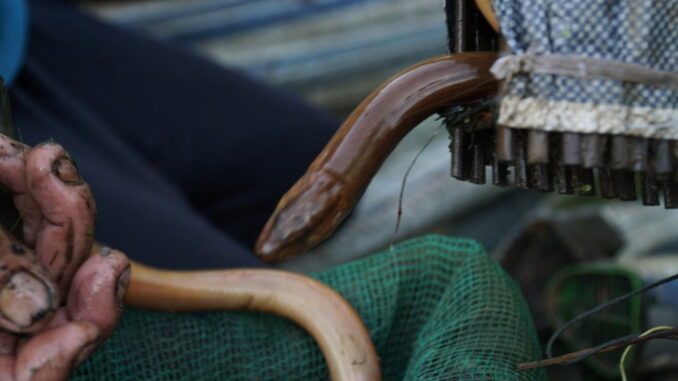
DONG THAP – Men following the ditches in the middle of the field, Mr. Tran Van Tung, a native of Cao Lanh district, ordered 80 rice cakes, the next day he poured three kilograms of eels and sold them for nearly 400,000 VND.
At 4 a.m., Mr. Tung left home to take shelter in Dong Thap Muoi district, tied a plastic can in half to hold eels, covered with a net outside, and bait – yellow post snail intestine prepared from yesterday afternoon. Going to the rice field at the time of harvest, he collected and talked with some farmers who went to the fields early in the morning.

With 30 years of experience in the profession, the U50 man remembers exactly where he placed his shelter yesterday on a kilometer-long ditch. He waded into the water about a meter deep, reaching out his hand to grab two mugs placed close together. Usually the pods are placed under the grass or shade, where eels like to live. After decades of work, he could only tell by looking at the grass where there were many eels.
Trum is made of bamboo, 0.7 m long, a round cylinder the size of a calf, the outside is covered with a hat, creating a dark space for the eels to live in. Near the end of the pot, there is a small bamboo stick in the mouth, where the bait is inserted and the eel is emptied. Each cluster has two days of bamboo (a type of trap, eels can easily get in but can’t get out) at the top and middle. Bamboo costs about 40,000 VND per day and can be used for two years.
Placing the collected lottery numbers on the shore, he took the others, located about 2 meters apart. When he finished, he returned, carried more than a dozen in each hand, and brought it to the car. Particularly for the ditches deeper than 1.5 m, Mr. Tung only placed them along the banks and used grass to cover them. It took more than two hours to collect the number of traps set, his body was running fast, his face was also covered with mud. Gathering in a vacant lot, he began to pour eels into the can.

The number of eels caught in a trap alone is quite small, usually 3-4 at the same time, different sizes. Catching an eel in his hand, he pointed to a yellow-bellied field eel, a dark brown back, the recognizable part is a long, pointed tail that is not fat like a farmed eel. Lifting the eel can, he was estimated to be three kilograms, 2-3 kilograms less than usual. On average, every day he earns several hundred thousand dongs, one day he can win up to a million.
After pouring the eels, he added bait to the pot, put it back to collect tomorrow. Each location is not consecutive, must be spaced 3-4 days apart. Therefore, he must have more than a dozen eel traps ready. For many years in his profession, Mr. Tung is most afraid of areas with broken bottles and sharp objects. In addition to wearing thick socks, he also marked dangerous ditches to avoid. Entering the profession, he also avoids quarrels with local people, afraid of being destroyed or stolen.

Soaking in water all year round, Mr. Tung’s limbs are all rotten, and his skin often has a heat rash. He shared that those who choose this profession to go to the street are easily shunned by others, because the amount of eels often stinks, few people want to get close. Being ordered by his grandfather, Mr. Tung likes the feeling of catching big eels. The job of trapping eel is hard, but thanks to it, he can raise two well-educated children. This year is old, he has no intention of retiring.
Large types of eels cost 220,000 VND per kg, medium types cost 150,000-170,000 VND, small types cost only a few tens of thousands of VND per kg. People after catching or buying at the market can make dishes such as chili sauce, cook sour soup, fry with fish sauce…
Dong Thap Muoi is a wetland of the Mekong Delta, with an area of about 697,000 hectares, spread over three provinces of Long An, Tien Giang and Dong Thap. In the past, the land was rich in products such as fish, crabs, birds, storks, snakes… Now, due to the need for economic development, the area has become rice fields, aquaculture, and fruit trees. Natural products are becoming scarcer.
